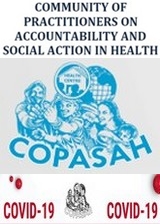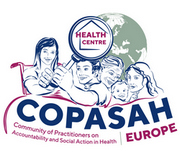Здружението ЕСЕ од 2012 година врши мониторинг на спроведувањето на Програмата за рана детекција на малигни заболувања со посебен осврт на компонентата за скрининг, односно рано откривање на карцином на грлото на матката. Врз основа на резултатите од мониторингот на оваа Програма, Здружението ЕСЕ согледа дека постојат потреби за унапредување во спроведувањето на Програмата и со таа цел формираше работна група составена од релевантни експерти (листата на лица вклучени во работната група е дадена во АНЕКС 4) што работеше на подготовка на предлог мерките за унапредување на спроведувањето на Програмата. Овој документ е подготвен од страна на работната група и има за цел да даде препораки до Министерството за здравство со цел зголемување на опфатот на жени и унапредување на квалитетот на услугите предвидени со Програмата за скрининг за карцином на грлото на матката.
Вознемирувањето на работното место претставува сериозен општествен проблем што до неодамна го немаше добиено потребното внимание ниту од пошироката јавност ниту од надлежните институциите во нашата држава. Ова делумно се должеше на фактот дека до 2013 година немаше посебен закон што ја регулира оваа појава, односно иако вознемирувањето од 2005 година беше регулирано во Законот за работни односи, сепак не постоеше „прецизно утврдена постапка и механизми за превенирање и справување со случаите на вознемирување на работното место“.
Во 2013 година беше усвоен Законот за заштита од вознемирување на работното место со што се утврди системска основа за превентивно дејствување и процесуирање на случаите на вознемирување на работното место. Во Законот се содржани одредбите за заштита и се пропишани процедурите и механизмите што им стојат на располагање на жртвите на вознемирување на работното место. Одредбите за заштита од сексуално вознемирување се однесуваат на вработените лица, но и на кандидатите за вработување.
Водич за заштита од вознемирување на работното место
The harmonization of our legislation with the European directives on discrimination and equal treatment of both men and women during recruitment and at the workplace resulted in regulation of the phenomenon of harassment at the workplace. This phenomenon was regulated for the first time in 20051 with the provisions of the Law on Labor Relations, which defined the phenomena of psychological harassment (mobbing) and sexual harassment at the workplace. After the initial regulation for harassment at the workplace in the Law on Labor Relations, in 2009 the law was supplemented with provisions2 that only refer to psychological harassment at the workplace (mobbing). The small number of foreseen provisions in the labor legislation that were introduced in 2005 and 2009 did not include a precisely established procedure and mechanisms for prevention and tackling this type of cases. This conclusion was verified by the findings and recommendations from conducted research3 by ESE with regard to these matters that pointed out the need for regulation of this phenomenon in a special law.
The regulation of this phenomenon in a special law in 2013 represents the first step to establish the base for prevention and adequate processing of cases of harassment at the workplace. However, its further adequate implementation is essential for proper and comprehensive tackling and suppression of the phenomenon of harassment at the workplace.
Therefore, as continuation of the previous action we have taken to ensure systematic monitoring of the phenomenon of harassment at the workplace, we conducted the analysis about the level of implementation of the Law on Harassment at the Workplace. The conducted analysis points out the problems and challenges which are faced by the workers and employers during the implementation of the law and also includes recommendations to overcome them.
The findings from this analysis can be used for taking further action in this area, i.e. to alarm and point out to the competent institutions about the need for implementation of the law in practice, as well as stimulation and encouragement of employees to utilize the law and the legal possibilities for protection in cases of harassment at the workplace.
Implementation of the law on protection from harassment at the workplace
Прирачникот за постапување на судиите во случаите на семејно насилство подготвен со крајнацел зголемување на степенот на судска заштита на жртвите на семејно насилство во граѓанските и кривичните судски постапки. Во истиот се вклучени детални информации за природата, карактеристиките, законската регулираност на семејното насилство, постапувањето на судиите во заштитата на жртвите и санкционирањето на насилното однесување на насилниците. Прирачникот е наменет за граѓанските и кривичните судии кои одлучуваат по предмети поврзани со семејното насилство и истиот може да се користи со цел соодветно применување на законските одредби кои налагаат заштита на жртвите на ова поле.
Впрочем, појдовна основа за подготовката на овој прирачник е фактот дека граѓанскоправниот и кривичноправниот систем на заштита претставуваат значаен механизам за заштита на жртвите на семејно насилство, при што од соодветната примена на законските одредби во пракса зависи сигурноста и безбедноста на жртвата и третманот на овој проблем во нашето општество. Истовремено, се упатува јасна порака кон насилниците за недозволивоста на нивното однесување и можноста за санкционирање и изрекување на законски предвидените казни. Од друга страна судиите можат активно да ги застапуваат интересите на жртвата и со тоа да повикаат на повисок степен на соработка и координација помеѓу останатите институции вклучени во системот на заштита, како што се обвинителството, полицијата, центрите за социјална работа и др.
Прирачник за постапување на судовите во постапките за заштита од семејно насилство

Previous research studies and field work underline the unfavourable socio-economic and living conditions of Roma people, which result in barriers related to their access to health services and contribute to their disadvantaged health status. In addition, having in mind the unfavourable situation of women, especially Roma women in the Macedonian society, it is of utmost importance to researchthe connection between gender and several parameters of health, access to health care and exercise of health rights among Roma respondents.
In particular, this analysis addresses the gender perspectives of health in terms of scope, type and quality of health services received by Roma men and women, with special focus on health services provided by registered general practitioners, emergency medical services, and out-patient and in-patient health care. One section addresses issues related to access to and quality of health services, as well as patients’ rights exercised by Roma men and women. Moreover, this document analyses the effect of respondents’ gender on their self-reported health status and frequency of acute and chronic diseases.
All parameters are analysed by means of comparisons of answers provided by Roma women (393 respondents) and Roma man (298 respondents).
CONCLUSIONS
HEALTH STATUS
Respondents’ gender has a visible effect on their self-reported health status. Higher share of Roma mencompared to Roma women assessed their health as “very good”. Health status of Roma women is moreunfavourable, as they more frequently reported that they have been diagnosed with STDs and suffer from chronic health problems that require regular health care services.
PRIMARY HEALTH CARE
Gender of Roma respondents does not affect their coverage with registered general practitioners orutilization of services in primary health care. More specifially, equal shares of Roma men and women have selected their registered general practitioner and benefied from emergency medical services.
SECONDARY HEALTH CARE
Despite the fact that respondents’ gender does not affect the general level of utilization of services in out-patient health care, it still determines the scope of services provided at certain types of public health facilities, such as general or clinical hospitals and health care centres. Number of visits to these types of public health facilities reported by Roma women is almost twice as high as the numberof visits reported by Roma men. Insignificant effect of Roma respondents’ gender was observed in terms of their satisfaction with the behaviour of specialist medical doctors and the quality of health services received. Therefore, more than half of Roma men and women, in almost identical shares, are completely satisfied with the behaviour demonstrated by specialist medical doctors and the quality of health services received.
TERTIARY HEALTH CARE
Utilization of services in in—patient health care is insignificantly higher among Roma women. Consequently, Roma women are more satisfied with the behaviour of medical doctors and medical staff, as well as the health care services received during their hospital stay.
PATIENTS’ RIGHTS
Gender does not condition Roma respondents’ exercise of their patients’ rights, with the exception of the right to insight in medical records, as more Roma women requested and were granted insight in their medical records.
ACCESS TO MEDICINES
Respondents’ gender does not result in different access to prescribed medicines from the positive list approved by the Health Insurance Fund (HIF). Namely, almost equal shares of Roma women and men were unable to fid the medicines in pharmacies at HIF’s cost.
DISCRIMINATION
Unkind behaviour and poor treatment on the part of specialist medical doctors was reported by both, Roma men and Roma women. Contrary to the situation observed in terms of the treatment on the part of specialist medical doctors, Roma men more frequently reported unkind behaviour and poor treatment during their hospital stay.
Gender perspectives of Roma Health and their access to healthcare





































